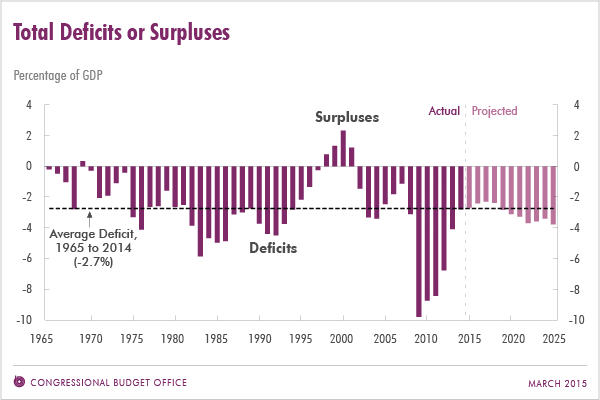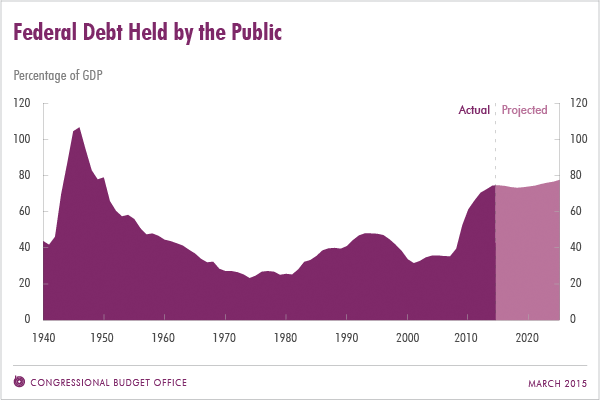March 9, 2015 - As it typically does after the President’s budget is released, CBO has updated the baseline budget projections it published earlier in the year. CBO now estimates that if the laws that currently govern federal taxes and spending generally remain in place, the federal budget deficit will total $486 billion in fiscal year 2015, about the same as the shortfall posted in 2014. However, because the nation’s output (its gross domestic product, or GDP) has increased, the deficit projected for 2015 represents a slightly lower percentage of GDP—2.7 percent—compared with 2.8 percent last year. In 2009, the deficit peaked at 9.8 percent of GDP; as recently as 2011 it was equal to 8.5 percent of GDP (see figure below).

Under the assumption that current laws will generally remain unchanged, the budget deficit is projected to decline in 2016, to $455 billion, or 2.4 percent of GDP, and then to hold roughly steady relative to the size of the economy through 2018. Beyond that time, however, the gap between spending and revenues is projected to grow faster than GDP: The deficit in 2025 is projected to reach $1.0 trillion, or 3.8 percent of GDP, and cumulative deficits over the 2016–2025 period are projected to total $7.2 trillion.
CBO’s estimate of the deficit for 2015 is $18 billion greater than the shortfall it projected in January, mostly because the agency has increased estimated outlays for student loans, Medicare, and Medicaid. In contrast, the projected deficits for the 2016–2025 period total $431 billion less than the cumulative deficit that CBO projected in January. The largest factor underlying that reduction is a downward revision to projected growth in private health insurance spending, which is estimated to lower the net cost of the provisions of the Affordable Care Act (ACA) that are related to insurance coverage and to increase overall revenues from income and payroll taxes (because a larger share of employees’ compensation over the coming decade is now projected to be paid in the form of taxable wages and salaries).
With such deficits, CBO projects that federal debt held by the public would amount to 73 percent or 74 percent of GDP over the next several years—more than twice what it was at the end of 2007 and more than in any previous year since 1950 (see figure below). By 2025, in CBO’s baseline projections, federal debt rises to 77 percent of GDP.

Such high and rising debt would have serious negative consequences for the nation: When interest rates returned to more typical, higher levels, federal spending on interest payments would increase substantially. Moreover, because federal borrowing reduces national saving over time, the nation’s capital stock would ultimately be smaller and productivity and total wages would be lower than they would be if the debt was smaller. In addition, lawmakers would have less flexibility than otherwise to use tax and spending policies to respond to unexpected challenges. Finally, a large debt increases the risk of a fiscal crisis, during which investors would lose so much confidence in the government’s ability to manage its budget that the government would be unable to borrow at affordable rates.








